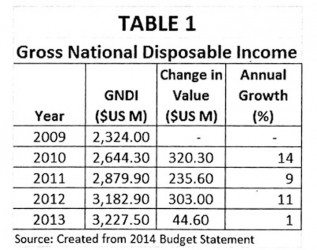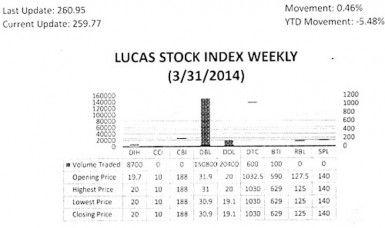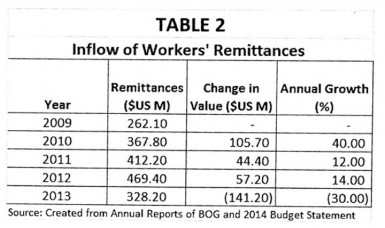Barely moved
Despite a major decline in the amount by which gross national disposable income (GNDI) increased last year as revealed in the 2014 budget statistics, the government expects the economy to grow by 5.6 per cent this year. The Guyana economy depends heavily on consumer spending which accounts for about 70 per cent of the money spent in the economy as it does on export revenues and workers’ remittances. It is the first time in a long time that the gross national disposable income has barely moved, increasing in 2013 by US$44 million or a mere 1.4 per cent over 2012. This is a dramatic slowdown in the flow of money available for spending by the nation as a whole in comparison to previous years. The rate of increase from 2009 to 2013 averaged 8.56 per cent with the highest increase of 13.78 per cent![]() being recorded in 2010. GNDI, in the years after, recorded increases of 8.9 and 10.5 per cent. However, 2013 took a turn for the worse and registered the lowest increase seen in years as could be gleaned from Table 1 below. This development is important because GNDI is a determinant of material living standards and its marginal change threatens future investment, economic growth and personal well-being.
being recorded in 2010. GNDI, in the years after, recorded increases of 8.9 and 10.5 per cent. However, 2013 took a turn for the worse and registered the lowest increase seen in years as could be gleaned from Table 1 below. This development is important because GNDI is a determinant of material living standards and its marginal change threatens future investment, economic growth and personal well-being.
 A rise in real disposable income means not only a rise in the capacity for current consumption, but also an increased ability to accumulate wealth such as houses, machinery, financial assets and the like, which could be used to create future income and lead to future consumption. The small nominal increase which Guyana experienced last year could have the opposite effect since less money is now available for consumption and possibly savings. The data suggest also that in the relationship between the change in income and the change in consumption substantial amounts of borrowing took place in 2013. The implications of this latter issue would be examined separately.
A rise in real disposable income means not only a rise in the capacity for current consumption, but also an increased ability to accumulate wealth such as houses, machinery, financial assets and the like, which could be used to create future income and lead to future consumption. The small nominal increase which Guyana experienced last year could have the opposite effect since less money is now available for consumption and possibly savings. The data suggest also that in the relationship between the change in income and the change in consumption substantial amounts of borrowing took place in 2013. The implications of this latter issue would be examined separately.
Best indication
This national statistic is identified with gross national product (GNP) which is measured using market prices. Indeed, GNP at market prices provides the best indication of the amount of money that is available for use in the national economy. National income at market prices includes income such as rent, interest, and wages that are paid to factors of production such as land, warehouses, financial capital and labour that are used in the process of producing and distributing goods and services. It also includes the taxes like those of excise and value-added tax (VAT) paid during production and the purchases made at the retail level. To ensure that the figure reflects income generated and owned by the various economic agents, the subsidies that are given to private sector producers by the government are removed from the figure.
It is important to recognize too that national income takes account of money which is paid to foreign institutional units and that which is received from similar institutional units in the rest of the world. These payments would include taxes on income, social contributions and other transfers. GNDI is a comprehensive figure and generally reflects the critical elements for measuring income in countries like Guyana with small economies.
The annual reports of the Bank of Guyana identify the transfers between Guyana and other countries typically as money sent abroad by foreign workers in Guyana and money sent to bank accounts abroad. The budget statement points out other movements that include royalties and fees. These latter payments are presumably for the privilege of operating enterprises like fast food franchises and using other proprietary technologies in the production process in Guyana. The outflows also include profits that foreign companies operating in Guyana repatriate to their home countries. Similar transfers take place on the inflow side. Guyanese companies with foreign subsidiaries receive profits that are repatriated if not left overseas for strategic reasons. Guyana also receives workers’ remittances and money from the foreign bank accounts that Guyanese have abroad. Estimates of the value of goods sent in barrels and boxes and net movement in monies by embassies are also part of the transfer payments.
Consequence of decline
 Over the last five years, the trend in the net movement of the non-factor transfers as reported by the Bank of Guyana has always favoured Guyana (see Table 2 below). This is largely driven by the sizable net inflow from remittances. More money flowed in from Guyanese working abroad than flowed out from foreigners working in Guyana. While that relationship has not changed, the consequence of its decline on national income has produced the uncharacteristically small increase in disposable income last year. If this trend continues, it means that households would have less money to lend to the government and private sector for investment purposes.
Over the last five years, the trend in the net movement of the non-factor transfers as reported by the Bank of Guyana has always favoured Guyana (see Table 2 below). This is largely driven by the sizable net inflow from remittances. More money flowed in from Guyanese working abroad than flowed out from foreigners working in Guyana. While that relationship has not changed, the consequence of its decline on national income has produced the uncharacteristically small increase in disposable income last year. If this trend continues, it means that households would have less money to lend to the government and private sector for investment purposes.
Threat to future growth
The threat to future growth also comes from a potential decline in export revenues. For the past several years, the major driver of export revenues has been gold. The metal is not only precious to its owners. It is precious to the Guyana economy since it accounted for 55 per cent of the foreign revenue generated by the major exports from Guyana last year. The activity in that industry has been strong for the past six years as the price of gold climbed to record level and output responded accordingly. The activities of this industry contributed substantially to the energy seen elsewhere in the economy, particularly in the retail and wholesale distributive trades. Falling gold prices were likely to result in a reduction in the level of investment in the gold industry. It is probably the reason the government has projected rather conservatively that output in the mining sector was likely to increase by less than two per cent and revenues from gold to remain virtually unchanged from last year.
Foreign financing
Consequently much of what happens in 2014 hinges on the performance of the export sector, but more particularly gold and to a lesser extent rice. Both production and prices for Guyana’s major exports would have to rise. For investment spending to increase in a case where gross national disposable income has declined sharply, it would have to depend more on financing from foreign sources. Guyanese should expect therefore that the current account deficit would rise and so would Guyana’s foreign debt in 2014.










